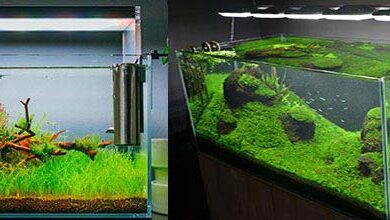LED VS Fluorescent Aquarium Light

The correct aquarium lighting is necessary to illuminate and showcase the spectacle that is your tank. It is an important part of an aquarium decor and can bring the spotlight from a room right into the tank. Whether you’re using a soft backlight to make your tank glow from the inside out or a bright light over your aquarium, it’s important to have one for more than just decorative purposes.
Any type of aquarium should have some type of lighting system within the chambers to promote a healthy environment for both the plant and marine life that lives in your tank. Aquarium lighting is a driving force behind a long-lasting and healthy association with your aquarium and its contents.

LED VS Fluorescent Aquarium Light Comparisons
Aquarium LED Light Aquarium Fluorescent Light
 |
 |
| Check the price | Check the price |
|
|
There are numerous options when it comes to aquarium lighting, with options for size, shape, wattage rating, unique features, and more. But the most common question people ask themselves or experts is what is the difference between traditional fluorescent aquarium lights and modern LED ones? While they ultimately serve the same purpose, there are some revealing differences between each product and today we’re going to break them down.
Aquarium LED Light

LED actually translates to light-emitting diode and uses electrical currents to create cool, soft light. LED lights have tiny microchips in each bulb that convert tiny electrical currents into the light that we see shining off the glass. They can be purchased in numerous colors and offer a soft, warm or cool light for the aquarium.
LED lighting has risen in popularity for all your home needs, from small to large areas that require a light source and especially situations like aquariums that might require lighting for up to 12 hours a day. This rise in popularity may be due to the fact that it is not as bad for the environment or the wallet as halogen lights.
LED aquarium lights will also provide heat that will affect the temperature of the water within the tank, so it is important to determine how many lights are needed and how long they need to be on so as not to overheat the water with disastrous results.
fluorescent aquarium light

A fluorescent light bulb is the type of light bulb that is typically found throughout your home, both inside and out. Available in a variety of sizes, shapes, and lighting wattages, fluorescent lights use electrical currents and mercury vapors to produce a constant light source in the area in which they are placed. These mini electrical currents interact with the mercury vapors inside the tube where the bulb is housed and will emit a glow based on the selected power level.
Since many aquarium lighting systems use fluorescent bulbs, it’s easy to find a product that will benefit rather than harm your marine and plant life. Some light kits cannot be converted to an LED light system and, if possible, the bulbs may need to be purchased from a specialty store for a higher cost than you are comfortable with.
Although initially not as expensive as LED aquarium bulbs, their lifespan is noticeably shorter, leading to frequent bulb replacements. The good thing about this is that fluorescent bulbs are usually available at your local hardware store, but since they contain fumes; it is crucial to recycle them according to the instructions.
conclusion

So, we have just finished looking at the key differences and similarities between LED aquarium lights and fluorescent aquarium lights. There is really no clear cut answer as to which is better, but rather a solid understanding that the answer is honest, entirely up to the aquarium owner. If you have always used a fluorescent lighting system in your aquarium and don’t want to change this tried and true style of lights, then it may be time to upgrade to a newer, more efficient lighting system.
Perhaps you’re ready to make the switch to LED aquarium lights and just want to know where you can find information on how the switch will affect your marine life. Perhaps you were curious as to why so many people are switching because it can’t just be for a cheaper monthly utility bill.
Talk to an expert at your local pet store or consult with avid fishkeepers through online forums to discover new and exciting ways to use your aquarium lights to their fullest potential.





